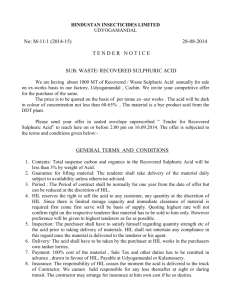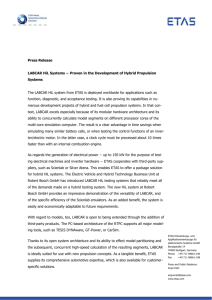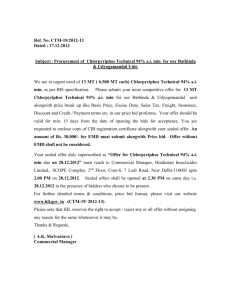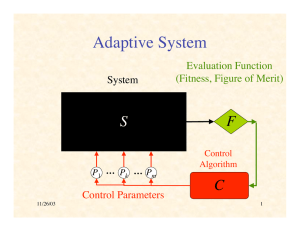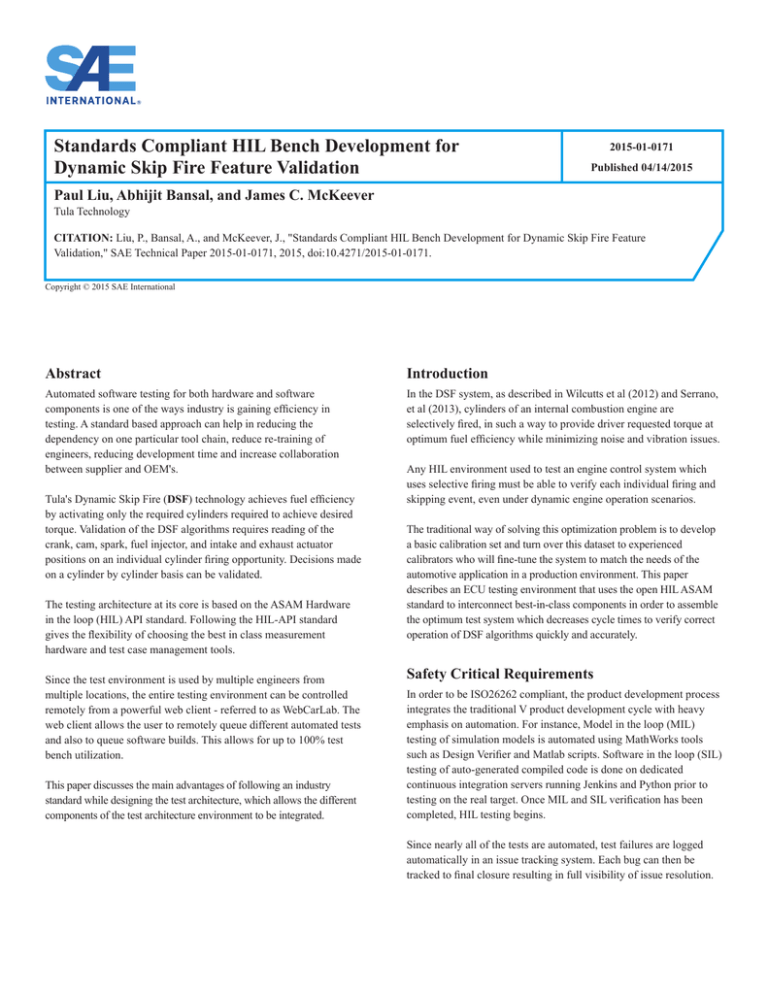
Downloaded from SAE International by James Mckeever, Wednesday, March 25, 2015
Standards Compliant HIL Bench Development for
Dynamic Skip Fire Feature Validation
2015-01-0171
Published 04/14/2015
Paul Liu, Abhijit Bansal, and James C. McKeever
Tula Technology
CITATION: Liu, P., Bansal, A., and McKeever, J., "Standards Compliant HIL Bench Development for Dynamic Skip Fire Feature
Validation," SAE Technical Paper 2015-01-0171, 2015, doi:10.4271/2015-01-0171.
Copyright © 2015 SAE International
Abstract
Introduction
Automated software testing for both hardware and software
components is one of the ways industry is gaining efficiency in
testing. A standard based approach can help in reducing the
dependency on one particular tool chain, reduce re-training of
engineers, reducing development time and increase collaboration
between supplier and OEM's.
In the DSF system, as described in Wilcutts et al (2012) and Serrano,
et al (2013), cylinders of an internal combustion engine are
selectively fired, in such a way to provide driver requested torque at
optimum fuel efficiency while minimizing noise and vibration issues.
Tula's Dynamic Skip Fire (DSF) technology achieves fuel efficiency
by activating only the required cylinders required to achieve desired
torque. Validation of the DSF algorithms requires reading of the
crank, cam, spark, fuel injector, and intake and exhaust actuator
positions on an individual cylinder firing opportunity. Decisions made
on a cylinder by cylinder basis can be validated.
The testing architecture at its core is based on the ASAM Hardware
in the loop (HIL) API standard. Following the HIL-API standard
gives the flexibility of choosing the best in class measurement
hardware and test case management tools.
Since the test environment is used by multiple engineers from
multiple locations, the entire testing environment can be controlled
remotely from a powerful web client - referred to as WebCarLab. The
web client allows the user to remotely queue different automated tests
and also to queue software builds. This allows for up to 100% test
bench utilization.
This paper discusses the main advantages of following an industry
standard while designing the test architecture, which allows the different
components of the test architecture environment to be integrated.
Any HIL environment used to test an engine control system which
uses selective firing must be able to verify each individual firing and
skipping event, even under dynamic engine operation scenarios.
The traditional way of solving this optimization problem is to develop
a basic calibration set and turn over this dataset to experienced
calibrators who will fine-tune the system to match the needs of the
automotive application in a production environment. This paper
describes an ECU testing environment that uses the open HIL ASAM
standard to interconnect best-in-class components in order to assemble
the optimum test system which decreases cycle times to verify correct
operation of DSF algorithms quickly and accurately.
Safety Critical Requirements
In order to be ISO26262 compliant, the product development process
integrates the traditional V product development cycle with heavy
emphasis on automation. For instance, Model in the loop (MIL)
testing of simulation models is automated using MathWorks tools
such as Design Verifier and Matlab scripts. Software in the loop (SIL)
testing of auto-generated compiled code is done on dedicated
continuous integration servers running Jenkins and Python prior to
testing on the real target. Once MIL and SIL verification has been
completed, HIL testing begins.
Since nearly all of the tests are automated, test failures are logged
automatically in an issue tracking system. Each bug can then be
tracked to final closure resulting in full visibility of issue resolution.
Downloaded from SAE International by James Mckeever, Wednesday, March 25, 2015
for the decision was the development of the HIL-API for dSPACE
and National Instruments products which facilitated interoperability
while maintaining flexibility at a reasonable cost.
Figure 1. Test Architecture
This system can be further expanded to the engine dynamometers.
The dynamometers use dSPACE and INCA tools which are supported
by the ASAM HIL API. Automation of dynamometer environment
configuration, test input profiles, calibration, logging, data archiving,
issue tracking and data post processing is possible.
Automated HIL Testing
Writing effective and efficient tests is a key objective when
automating HIL testing. Automated software testing for both
hardware and the software is one of the ways industry is trying to
gain efficiency in testing. Automated testing has the following
benefits over conventional manual testing:
Figure 2. Test HIL Hardware
Automated Test Architecture
As shown in figure 2 the automated test setup employs hardware
from different vendors in the current HIL setup. Each vendor has its
own proprietary platform access API. Trying to integrate different
proprietary methodologies presents a range of problems. The focus of
the test engineer must be more on validating the system under test
and not on struggling with HIL vendor hardware and software
integration. Thus there is a need for a common platform access API
that meets the following demands:
1.
Standard and reproducible tests: Standardizing the test
procedure takes out the human element from the tests.
1.
2.
Time effective: Tests take only a fraction of the manual test time
and saves man-hours as the user is not required to manually run
the tests.
Synchronization between the different hardware from
different vendors.
2.
Standardized functions for platform access.
3.
Fast execution of commands.
4.
Stimulus testing
5.
Triggered data capturing to synchronize and efficient recording.
3.
4.
Regression testing: Automated tests can be run overnight and
over the weekend without the presence of the user.
Test management: Automated tests can be easily synced with the
test requirements and are easily tracked.
Hardware Setup
The company relies on the synchronization of an NI Veristand test
environment with a dSPACE MicroAutobox (figure 2). The NI
Veristand simulates the engine whereas the dSPACE MABX acts as
the engine ECU. The dSPACE MABX is supplemented by the
dSPACE RapidPro hardware. Tula also employs a co-processor that
communicates to the simulated ECU through either a UDP or SPI bus
protocol. Since there is a co-processor as part of the solution, the
traditional approach of developing a customized test environment
would be expensive and take time to implement. The ideal solution to
the building of the test setup would be to get the best of automotive
HIL solution combined with the best in silicon validation
measurement and testing equipment. After extensive research, Tula
identified and built its first HIL bench using National Instruments and
dSPACE products because it offered the flexibility and the
expandability needed for developing and validating the company's
products and services at a cost effective price. One of the key reasons
After careful research and investigation the company selected the
ASAM HIL - API.
HIL - API: Open Connectivity through
Standard Compliance
HIL-API is a standard proposed by the automotive industry. ASAM
HIL-API defines a standard interface for accessing Hardware-In-theLoop systems. The standard has been created by German OEM's,
TIER-1 suppliers and the tool vendors within the ASAM committee.
The aim of the standard is to standardize access to different
simulation systems. This increases test reuse, helping to protect
investments and reduce development costs and time as it decouples
the hardware from the software.
HIL-API acts as an intermediary layer that helps the flow of data to
and from the hardware. Any software/hardware that is compatible
with this standard can be used with any other hardware/software that
supports HIL-API. Figure 3 shows how, with the help of HIL-API,
the hardware can be decoupled from proprietary software.
Downloaded from SAE International by James Mckeever, Wednesday, March 25, 2015
Because these standards help multiple test systems to interoperate,
the need to write tests using proprietary protocols is reduced to a
minimum. Using a single interface also reduces the complexity
associated with maintaining and tracking various tests scripts and
associated test hardware configurations.
Figure 4. Hardware trigger for syncing
5.
Figure 3. HIL- API
Why Chose HIL-API?
HIL-API meets the testing requirements while achieving a lot
of flexibility
1.
Response time: The average response time for read and write
is less than 1ms, this helps in executing tests at near model
sample rate.
2.
Stimulus testing: It is reliable, accurate and completely
scriptable. A particular example of doing this is during
calibration and verification of the engine speed at which the
co-processor turns DSF on. One can write an automated test that
creates a new engine speed stimulus in a loop and verifies that
the co-processor is running DSF.
3.
Data Capture: The data capturing is accurate with no missing
data points even at rates higher than 2 samples per millisecond.
This is particularly important when some of the trigger pulses
for the actuators are just one sample wide. Missing that one data
point can be very costly.
4.
Triggered Capturing: HIL-API also supports triggered
capturing. The trigger can be a very complex condition, for
example one can sequence conditions, so the second condition
is only checked after the first condition becomes true. Syntax:
Check this &> Then check this.
Triggers are very important as they help synchronize the
capturing of data for both NI and dSPACE hardware. The
setup employs a digital signal, which acts as a trigger for both
dSPACE and NI hardware as shown in figure 4. With this use of
a hardware trigger, data capturing was synchronized to within 1
sample point.
ASAM Standard: HIL-API is an ASAM standard which is
defined in both Python and C#. HIL API standardizes the
platform access. This results in high portability of tests. One
of the tests involves verification that a fuel injection pulse is
always followed by an ignition event within certain degrees of
engine rotation. This is a complex test that involves a complex
algorithm (Figure 5). There are many such tests which are even
more critical. With HIL API, the company knows that the time
invested in writing these complex tests is not wasted as the
tests can be easily ported to different hardware with minimal
effort. This will also help the company to share its tests with its
customers regardless of the hardware they are using as long as
they use hardware that follows the HIL-API standard.
Figure 5. Engine Actuator Test
6.
Object Oriented: The design of the HIL API standard is highly
object oriented, thus it is easy to use and completely scriptable.
It is also customizable and robust on different platforms. Being
platform independent and object oriented, the HILAPI has a
drawback that the objects need to be properly initialized and
handled. This can sometimes result in some extra steps. For
example, in order to do a simple write to a variable the steps
given in figure 6 need to be followed. However, with the use
of custom libraries, a simple method can be created as shown
in the figure 7. Now just by specifying the hardware being
Downloaded from SAE International by James Mckeever, Wednesday, March 25, 2015
used we can use the same block for any hardware. There are
many more places that this concept of encapsulation is used,
for example, to configure capture or stimulus etc. This helps
the company to create a set of custom libraries/wrapper to
simplify and speed up development.
The test setup uses a combination of HIL-API and dSPACE
AutomationDesk for the system testing. AutomationDesk is a test
creation and test execution software. The reasons for the selection are:
1.
Support for HIL API, thus supporting integration of hardware
from different vendors, such as NI and dSPACE hardware
support HIL API.
2.
Supports creation of custom libraries or blocks,
3.
Easy and effective test creations,
4.
It supports a combination of script and graphic based test creation.
5.
Control over the report generation
6.
API access to the software to enable integration with WebCarLab.
7.
Stable and Reliable testing.
WebCarLab
Figure 6. How to write using HIL-API
The test engineer's investment in writing scripts that use HILAPI is
protected as scripts can be ported with minimal effort to various HIL
environments that avail of the HIL API. With these points in mind,
the test team incorporated the HILAPI into its test environment.
To make automated testing available to a wider set of engineers and
provide remote access to running the tests, the company has
developed and uses a proprietary software called WebCarLab.
In embedded controls development access to a hardware in the loop
(HIL) testing environment can be a resource bottle neck. These HIL
systems are in demand from both testing and development
departments. There is therefore a need to bring HIL bench utilization
to 100%.
It is common for testing to be automated via test scripts. A test harness
is often created around a unit under test and test scripts automatically
ran to exercise inputs and check for expected system functionality.
The automation of test scripts alone does not go far enough. Ideally
the entire software build process, testing and results archiving should
be automated. Retrieval of test results and data/log files is important
for future reference and may be used for auditing purposes.
Version control of software and test scripts is a challenge. It is
important for the test engineer to be aware of both the test script and
software versions. This ensures bugs are easily traceable and
reproducible at a later date
Figure 7. Automation Desk HIL-API Write library block
HIL-API Test Setup
The basic software test architecture involves the use of HIL API with
dSPACE AutomationDesk
Figure 8. Test set-up
Often in software development, multiple platforms are supported by a
common code mainline. A build can be configured manually or by use
of a script to support multiple platforms or customers. Such a build
configuration process can be cumbersome and prone to human error.
Engineers often work in multiple site locations ensuring close
interaction with customers, suppliers and other process partners. In
person access to a HIL environment is not always possible at all
locations. Commonly “Live” remote access to a HIL environment can
be achieved by using a VNC client. This allows the test engineer
access for limited manual and automated testing from a remote
location. Even with a live VNC client, there is a risk that the remote
test engineer could interfere with tests already in progress on the HIL
environment. It is important that a schedule is communicated and
time for each engineer allocated. Such a methodology is difficult to
control and to administer.
Downloaded from SAE International by James Mckeever, Wednesday, March 25, 2015
These problems were common daily obstacles encountered by the
development and test teams. A fully custom in house solution has
been specified, designed and created called WebCarLab which
address all of the above points. WebCarLab is written in Python
Django and runs on in house Linux Servers. It provides the user with
24hr access to all HIL bench systems, version controlled test scripts
and source code.
added to WebCarLab as needed to support future projects.
WebCarLab is accessed by the user via a web browser. Engineers can
now log into a website on or off location and schedule tests on the
Perforce software version of their choosing. Deploying such a tool
means engineers now do not need to worry about the availability of
the HIL bench environment. Tests and software builds are queued and
executed in order on a first come first serve basis. Users can choose to
run their test and build job on the HIL environment of their choice.
The list of queued jobs is visible for each environment via the web
browser user interface.
Engineers can schedule a build and test job and walk away effectively
performing “lights out” testing of their code.
Figure 9. The automated test environment
Test scripts and software builds are checked into the version control
tool (Perforce) by the test engineer or developer. WebCarLab can
check out these files from the Perforce server automatically by using
a Perforce Python API.
Each HIL environment has a unique hardware topology file which is
needed during the build process. The Hardware topology file makes
the connection between the Simulink software under test and the
dSPACE rapid-pro hardware. During a manual build process the user
selects the HWT file in Simulink before performing the build. The
HWT file is normally stored manually on the HIL environment PC.
In order to automate the build process a method was needed to
configure the Simulink build with the correct hardware topology file
via the WebCarLab interface.
The solution comprised of a Matlab m-script which replaces the
current Simulink topology settings with a preconfigured topology file
block based on the HIL platform selected by the user.
For example, if HIL1 is selected by the user then WebCarLab will
check out the Simulink code from Perforce and then replace all
topology file blocks in the Simulink code with the pre-configured
topology block stored on the server. The complete process is fully
automated and invisible to the end user.
The company's engine control software supports multiple vehicles,
customer and test environment platforms. In order to perform the
variant builds reliably, the user can use WebCarLab to configure the
build for the particular variant required. The user selection triggers
WebCarLab to run test scripts from Perforce which configure the
build for the platform/Customer in question. The platform build
executable and source files are archived in the database for future
reference. Pre-build configuration test scripts can be modified and
Figure 10. The Tula WebCarLab web browser interface
The test logs, builds and other files which are created by the job are
stored on the WebCarLab Linux server and are easily available for
download at a later date.
WebCarLab uses a Linux server to store the files and the web
interface can download the files selected by the user via an SQL
database. All of this is back end process is invisible the end user.
The WebCarLab browser has a built in VNC client to allow the user
to view “Live” HIL bench behavior or to perform manual tests
remotely. Automated Test scripts can be selected by the user from a
pool of released tests stored on the Perforce server. Having a pool of
released tests available to all engineers via a web interface allows
developers to perform more regression and means less support is
needed from test engineers during integration/debug of issues. This
leaves test engineers more time to write new tests and focus on tasks
such as code coverage.
The quality metrics monitored to determine success of the
WebCarLab project were: Bench utilization, test team support needed
during development/integration and finally number of bugs found
during integration before initial release. All quality metrics showed a
marked improvement after the implementation of the WebCarLab
automation tool
Summary/Conclusions
By utilizing an industry standard an automated hardware in the loop
testing environment was created enabling Tula's Dynamic Skip Fire
(DSF) to be fully tested. Best in class hardware and software from
different vendors were integrated into one HIL platform using the
HILAPI. A test harness was created around the system under test
Downloaded from SAE International by James Mckeever, Wednesday, March 25, 2015
using both dSPACE and NI vendor equipment. The HILAPI allowed
the test engineers easy access to both the NI and dSPACE
environments via test scripts.
2.
Serrano, J., Routledge, G., Lo, N., Shost, M. et al., “Methods of
Evaluating and Mitigating NVH when Operating an Engine in
Dynamic Skip Fire,” SAE Int. J. Engines 7(3):1489-1501, 2014,
doi:10.4271/2014-01-1675.
Automation of the entire build, test and data archiving process was
achieved using an in house web HIL Interface.
3.
Test bench utilization was increased from 40% to 90% with engineers at
various locations now fully availing of the HIL remote access features.
Bansal A., Muli M., Patil K. “Taming Complexity While
Gaining Efficiency: Requirements for the Next Generation of
Test Automation Tools”, IEEE 2013
4.
Krisp, H., Lamberg, K., and Leinfellner, R., “Automated RealTime Testing of Electronic Control Units,” SAE Technical Paper
2007-01-0504, 2007, doi:10.4271/2007-01-0504.
The number of software bugs found pre-release doubled with more
developer testing allowing resolution of issues before software
release candidates were created.
Further gains are possible by transferring the automation techniques
discussed to the dyno test environment.
Definitions/Abbreviations
NI - National Instruments
DSF - Dynamic Skip Fire
References
1.
Wilcutts, M., Switkes, J., Shost, M., and Tripathi, A., “Design
and Benefits of Dynamic Skip Fire Strategies for Cylinder
Deactivated Engines,” SAE Int. J. Engines 6(1):278-288, 2013,
doi:10.4271/2013-01-0359.
The Engineering Meetings Board has approved this paper for publication. It has successfully completed SAE’s peer review process under the supervision of the session organizer. The process
requires a minimum of three (3) reviews by industry experts.
All rights reserved. No part of this publication may be reproduced, stored in a retrieval system, or transmitted, in any form or by any means, electronic, mechanical, photocopying, recording, or
otherwise, without the prior written permission of SAE International.
Positions and opinions advanced in this paper are those of the author(s) and not necessarily those of SAE International. The author is solely responsible for the content of the paper.
ISSN 0148-7191
http://papers.sae.org/2015-01-0171


